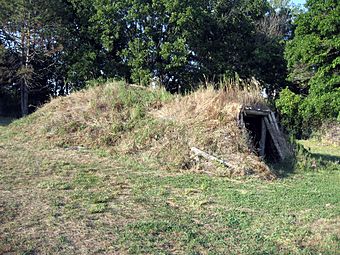Chan-Ya-Ta Site facts for kids
Quick facts for kids |
|
|
Chan-Ya-Ta Site
|
|

A reconstructed earthlodge
|
|
| Lua error in Module:Location_map at line 420: attempt to index field 'wikibase' (a nil value). | |
| Nearest city | Linn Grove, Iowa |
|---|---|
| NRHP reference No. | 78001209 |
| Added to NRHP | November 21, 1978 |
The Chan-Ya-Ta Site (pronounced "chen-yata") is an ancient village located in Buena Vista County, Iowa, United States. It was once home to Native Americans during the Late Prehistoric period, around 1100 to 1200 CE. These people lived in large homes called earthlodges, and their village was protected by a ditch.
The site is a very important part of the Mill Creek Culture, a group of Native Americans who lived in northwest Iowa a long time ago. The name "Chan-Ya-Ta" comes from the first letters of the names of the landowners who allowed archaeologists to study the area. This site was also where the very first field school for the Iowa Archeological Society took place, helping young archaeologists learn about the past.
Contents
What Was the Chan-Ya-Ta Site?
The Chan-Ya-Ta Site was a busy village where many Native Americans lived. It was a well-organized community with special features that helped protect its residents. Archaeologists have learned a lot about how these people lived by studying the remains of their homes and tools.
Earthlodges: Ancient Homes
The main homes at Chan-Ya-Ta were called earthlodges. Imagine a large, round house built partly into the ground. These homes had strong wooden frames covered with layers of earth, grass, and sod. This design made them very sturdy and helped keep the people inside warm in winter and cool in summer.
- Earthlodges were often quite big, holding several families.
- They usually had a central fireplace for cooking and warmth.
- A smoke hole at the top allowed smoke to escape.
- The entrance was often a long, covered passageway.
Fortified Village Design
The Chan-Ya-Ta village was not just a collection of homes. It was also fortified, meaning it had defenses to protect the people. The most notable defense was a ditch that surrounded the village.
- This ditch would have made it harder for enemies to attack.
- Sometimes, these ditches were combined with wooden fences or palisades.
- The fortifications show that the people of Chan-Ya-Ta needed to protect themselves.
Who Were the Mill Creek People?
The people who lived at Chan-Ya-Ta were part of the Mill Creek Culture. This culture thrived in northwest Iowa for about 100 years, from 1100 to 1200 CE. They were skilled farmers and hunters who adapted well to their environment.
Daily Life and Activities
The Mill Creek people were very resourceful. They grew crops like corn, beans, and squash, which were important parts of their diet. They also hunted animals such as deer and bison for food and materials.
- They made pottery for cooking and storing food.
- Tools were crafted from stone, bone, and wood.
- They traded with other groups, bringing in materials not found locally.
What Happened to the Mill Creek Culture?
Around 1200 CE, the Mill Creek Culture began to decline. Archaeologists are still studying why these villages were abandoned. Possible reasons include changes in climate, conflicts with other groups, or a shift in how people lived and moved across the land. The Chan-Ya-Ta Site gives us important clues about their lives and their eventual disappearance.
Why Is Chan-Ya-Ta Important Today?
The Chan-Ya-Ta Site is very important for understanding the history of Native Americans in Iowa. It helps archaeologists piece together what life was like hundreds of years ago.
Learning from the Past
By carefully digging and studying artifacts at sites like Chan-Ya-Ta, archaeologists can learn about:
- The types of food people ate.
- The tools they used for hunting, farming, and daily tasks.
- How their villages were organized and defended.
- Their beliefs and customs, sometimes seen through special objects.
A Place for Discovery
The Chan-Ya-Ta Site was the location of the first field school for the Iowa Archeological Society. This means it was a place where students and new archaeologists could learn hands-on how to properly excavate and record archaeological findings. This makes the site not only a historical treasure but also a place of learning for future generations of scientists.

